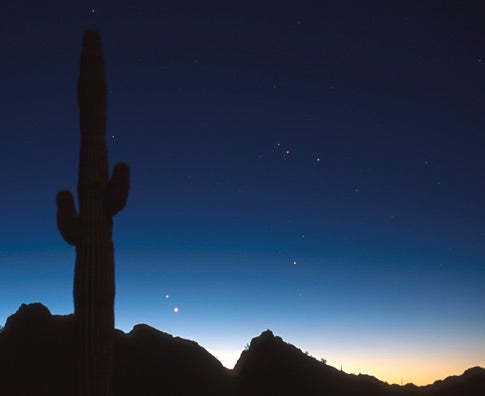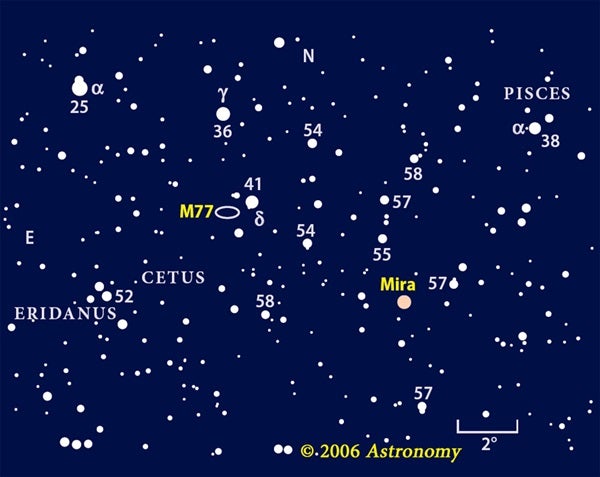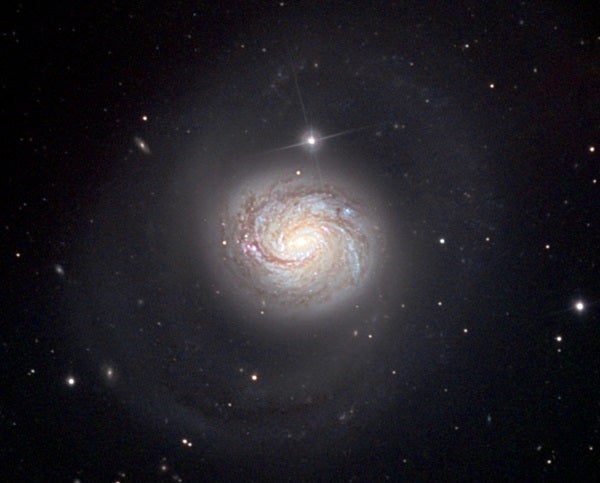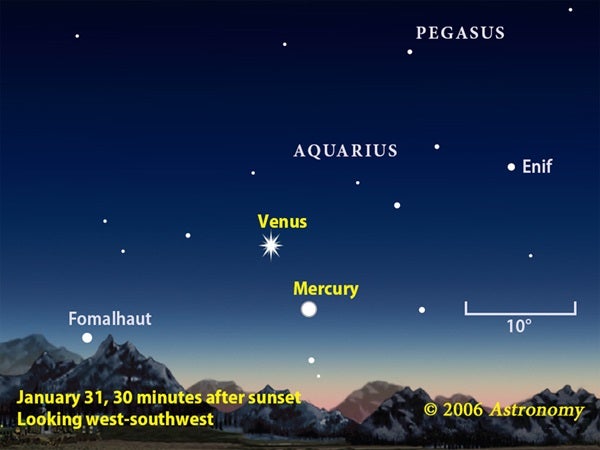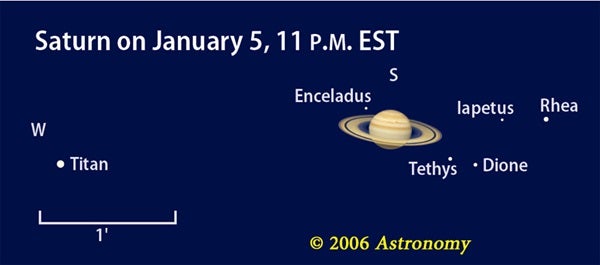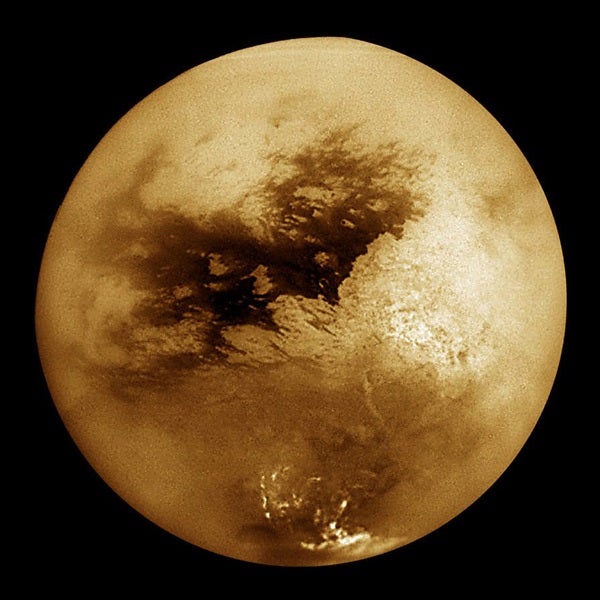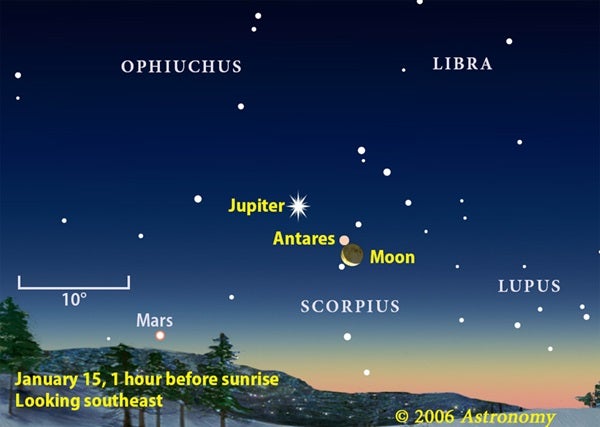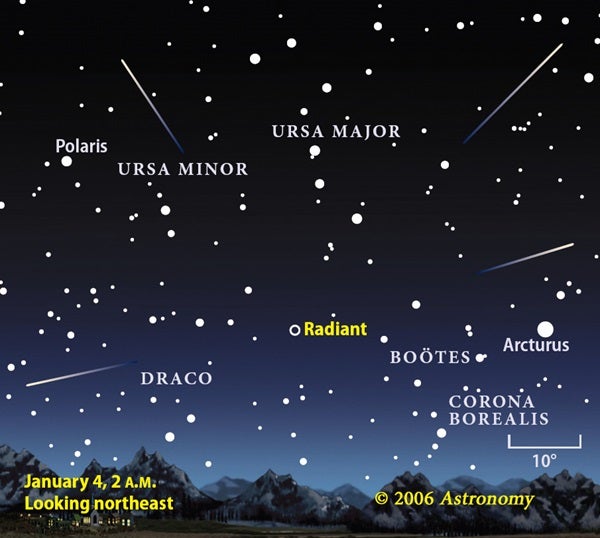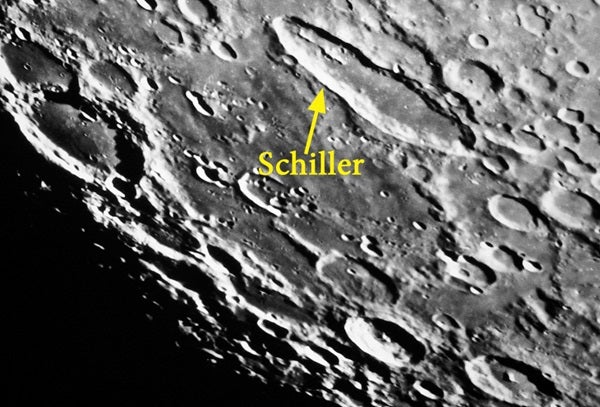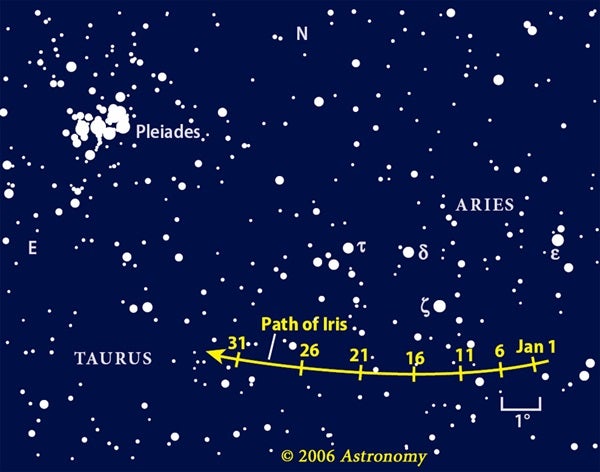As January begins, Venus appears slowly through the bright yellow-orange glow, low in the southwest about 30 minutes after sunset. Week by week, the cloud-covered planet inches higher and sets a little bit later. Through a telescope, Venus displays a tiny, shimmering disk. But in a few months, it will grow and thin into a resplendent crescent.
Mark your calendar for January 20, when Venus has a pretty conjunction with the crescent Moon. Find a location with an unobstructed southwestern horizon so you can watch the pair as long as possible. As the sky darkens, you should see gray earthshine — the “old Moon in the new Moon’s arms” — filling out the crescent.
Speedy Mercury begins a fine evening apparition during the last week of January. It’s bright Β shining at magnitude 1.0 — and easy to see through binoculars to Venus’ lower right. In early February, the innermost planet will be a snap to see with the unaided eye.
With all the bright, sparkling winter stars commanding the eastern sky after darkness falls, you can be forgiven if you miss Saturn closer to the horizon. Because Saturn’s not a point source like a star, its light does not twinkle as it passes through the turbulent lower layers of our atmosphere. However, this turbulence blurs the planet’s globe, delicate rings, and tiny moons when viewed through a telescope. Be patient, and wait until the ringed wonder climbs reasonably high in the south by 11 P.M. or so. Over the next several weeks, Saturn pulls slowly away from blue-white Regulus, Leo the Lion’s brightest star.
Most backyard observers enjoy dynamic solar system events in part because the background universe usually doesn’t change at all. Conjunctions between planets typically progress at a modest rate and can withstand a cloudy night or two. Events involving the Moon transpire much faster, however, and require clear weather on specific nights. During an occultation, the Moon blots out a background star or planet. If you’re in the right place, the object can both disappear behind the Moon and reappear up to an hour or so later.
From its northernmost point next to Beta (Β)Tauri January 1, the Moon slides south and east. On the morning of the 6th, Alaskans can see it occult Saturn. By the time the Sun sets that evening, the Moon lies between Saturn and Regulus. A lovely photo-op happens before dawn January 15 when Jupiter, ruddy Antares, and the waning crescent Moon all line up.
Does the sight of a slender crescent Moon only 24 hours old make you gasp? Then the even tinier sliver presented by an 18-hour newborn may take your breath away. The evening of January 19 provides a prime chance for observers along the East Coast — if you find high ground with an unobstructed southwestern horizon.
To spot the Moon, you’ll need to search for it with binoculars just 20 or 25 minutes after sunset. First, locate Mercury in the bright twilight glow barely above the horizon. To the left in the same field of view lies the Moon’s faint, yellow arc. By the time Earth has turned to favor West Coast observers, the Moon will be 21 hours old and positioned to Mercury’s upper left. Seeing a Moon this young is far from easy — even many experienced observers have never seen one.
A special ruby stars in this story of the sea. Mimicking the graceful arc of a humpback whale surfacing and submerging, the celestial whale Cetus rises in the east, crests in the south halfway to the zenith, and sets in the west. During January, Cetus appears at its highest just after darkness falls. Seen from the Southern Hemisphere, Cetus performs a full breach nearly overhead.
Once every 11 months, a faint, pale-red star brightens to a lovely orange-topaz and adorns the blank central area of the Whale. The star, known as Mira, then returns slowly to obscurity over the next several months.
Until David Fabricius (1564–1617) discovered Mira’s variability in 1596, Cetus must have swum in poorly charted waters. Even the esteemed celestial cartographer Johannes Bayer (1572–1625) thought Mira was just an ordinary star. Bayer assigned each bright star a Greek letter, a system we still use today, and designated Mira Omicron (ο) Ceti.
Unlike the clockwork plunge and recovery of Algol in Perseus, Mira flaunts its variability. In 1779, Sir William Herschel (1738–1822) witnessed a peak that challenged the brightness of 1st-magnitude Aldebaran.
In other years, Mira barely surfaced to the unaided eye. How will it compare this time to its typical peak near magnitude 3.5? No one knows. Mira’s pulsation period averages 332 days, but it can be fast or slow by as much as 20 days. This year, astronomers predict maximum to come in early March.
Use the chart above to gauge Mira’s brightness. The numbers next to some stars are their magnitudes, with the decimal points removed to avoid confusing them with stars. To estimate Mira’s magnitude, find one star a little brighter than Mira and a second a bit fainter. Then, figure where Mira falls between those two.
Things are not always what they seem. Edwin Hubble (1889-1953) showed that many of the sky’s nebulous patches of light are distant galaxies. Albert Einstein (1879-1955) taught us that extremely dense objects warp space and behave in counterintuitive ways.
The blazing, pinpoint core of spiral galaxy M77 led astronomer Carl Seyfert to recognize it as a new class of galaxies with active nuclei. Later, astronomers realized M77 lies on the quieter side of the activity range, a scale that places quasars at the top. Galaxies like M77 are now known as Seyferts.
You shouldn’t have too much trouble finding M77. First, locate the three brightest stars in Cetus’ head: Alpha (α), Gamma (γ), and Delta (δ) Ceti. From Delta, slide 50′ (a bit less than 2 Moon-widths) southeast. You’ll notice M77’s bright core right away. Hidden inside this fuzzy dot is a black hole devouring ripped-apart stars.
Under a dark sky, the galaxy’s disk becomes visible. Although most backyard observers will need at least a 12-inch scope to see spiral structure, a patient observer should notice some mottling through a 5-inch. Afterward, aim your scope at M32, one of the Andromeda Galaxy’s companions, and you’ll see a much smoother distribution compared with M77’s lumpiness.
Planetary observers have tempting targets throughout these long winter nights. Venus lies low in the southwest during evening twilight and grows more prominent as January progresses. Mercury joins Venus late in the month. Saturn rises a couple of hours after sunset and appears spectacular among the stars of Leo. Then, as dawn approaches, Jupiter and Mars both come into view.
Aim your telescope at Venus in early January, and you’ll see a nearly full disk that spans 10″. The planet’s 96-percent-lit phase wanes imperceptibly, to 92-percent lit, during the month. More dramatic changes await observers this spring and summer. On January 20, look for a slim crescent Moon just 3° above Venus.
By the end of the month, Venus has company. Climbing out of the twilight, Mercury begins a fine evening show. You can spot this normally elusive planet 10° below Venus January 22. It shines then at magnitude –1.1 — far fainter than Venus — and, like its brighter cousin, it shows a nearly full disk when seen through a telescope. However, Mercury is much smaller than Venus, so its disk reaches a mere 5″ across.
Mercury changes position more rapidly than Venus. By the 31st, the two planets have closed to within 7°, while Mercury’s phase has dwindled to 80-percent lit. With its increasing angular distance from the Sun, Mercury remains above the horizon a little longer and becomes easier to spot. Its visibility continues to improve through February’s first week, as the planet approaches greatest elongation from the Sun.
Uranus lingers in the evening sky during January, but try to catch it early in the month. It lies within 1° of 4th-magnitude Lambda (λ) Aquarii. The 6th-magnitude planet will be easy to see through binoculars.
By late January, Uranus has dipped to within 8° of Venus, and you’ll have to hunt for it an hour after sunset. Wait any longer, and Uranus will be lost in the haze. Neptune also lies in this vicinity — passing 1.4° from Venus January 18 — but the 8th-magnitude planet glows too dimly to pierce the twilight.
Saturn shines at magnitude 0.1, outshining all the bright stars nearby: Castor, Pollux, Regulus, and Procyon. The planet lies 770 million miles from Earth in mid-January, which means the light we see takes more than an hour to reach us. The Saturn-orbiting Cassini spacecraft sends its signals by radio waves, so it also takes more than an hour
to communicate with Earth.
After viewing the bland disks of Mercury and Venus, Saturn provides a dramatic punch. In mid-January, Saturn’s globe measures 20″ across, double Venus’ apparent diameter. With the rings’ north-south extent now down to 10″, a significant part of the planet’s north polar region is in view.
The rings still span 45″ east to west, offering spectacular views as the rings continue to narrow. By 2009, they will appear edge-on to our line of sight, essentially disappearing for a brief period.
Saturn’s moons change position noticeably from night to night, and, for some of the inner moons, from hour to hour. Titan glows at magnitude 8.4 and is the easiest one to identify. You shouldn’t have any trouble singling it out unless a similarly bright star lies in the same field of view, as happens January 18. Titan passes due north of Saturn January 3 and 19, and due south of the planet January 11 and 27.
Outer moon Iapetus passes north of Saturn between January 5 and 7. While all the other visible moons change position quite rapidly, Iapetus in its 80-day orbit takes its sweet time, so you won’t see much change from night to night. This two-faced moon brightens as it heads toward greatest western elongation January 25. It then glows at magnitude 10.1, some 5 times brighter than when it was well east of the planet in late December.
With Saturn nearing opposition, it’s a great time to look for its inner moons. Each now has its own personality, revealed through the thousands of images returned by Cassini. Enceladus, where liquid water lurks just beneath the frozen surface, glows at magnitude 11.8 and lies a little beyond the outer edge of the rings. Tethys shows up more easily because it’s both brighter (magnitude 10.3) and orbits farther from Saturn. It completes one revolution every 1.9 days. Dione scoots around Saturn every 2.7 days. At magnitude 10.4, it’s as easy to spot as Tethys. Rhea, the brightest of these inner moons (magnitude 9.7), takes 4.5 days to complete a circuit.
Jupiter doesn’t gain much altitude until twilight begins, so you’ll want to wait until then to get a good view of it through your scope. When you do, you should spot at least two dark, parallel cloud belts running across the planet’s 33″-diameter disk. You’ll also see Jupiter’s four bright moons: Io, Europa, Ganymede, and Callisto.
Jupiter resides in Ophiuchus some 5° north of 1st-magnitude Antares, the brightest star in neighboring Scorpius. A spectacular predawn sight awaits early risers January 15, when a waning crescent Moon lies just 1° to the lower right of Antares. Jupiter currently lies along the southern portion of its leisurely, 11.9-year orbit of the Sun. That means it never climbs high in the sky for Northern Hemisphere observers. (In contrast, those in the Southern Hemisphere are getting exceptional views.) Still, conditions will improve for everyone as Jupiter’s June opposition approaches.
Mars pokes above the horizon as dawn breaks. The Red Planet traverses the Milky Way in Sagittarius during January. On the 17th and 18th, it passes between the Lagoon (M8) and Trifid (M20) nebulae, although these faint fuzzies will be hard to see in the gathering twilight. By month’s end, Mars lies 3° north of 2nd-magnitude Nunki (Sigma [σ] Sagittarii). Mars won’t reach opposition until December, so it will take a long time to climb away from the twilight glow. Expect better views by mid- to late summer.
The Quadrantids, which can produce up to 120 meteors per hour, will be hard-pressed to deliver more than a couple of dozen per hour this year. Your best bet will be to wait until an hour before twilight begins, then position yourself so a building blocks the bright Moon as it sinks in the west. Quadrantid meteors radiate from the constellation Boötes the Herdsman, which rides high in the east before dawn.
According to the American Meteor Society, the rest of January can deliver up to 20 meteors per hour before dawn under a dark sky. Several minor showers with radiants stretching from Cancer to Virgo conspire to produce these “shooting stars.” The combined rates of these showers make up slightly for the lack of a good Quadrantid display. Yet only hot cocoa and many layers of clothes will make up for the winter cold in the hours before dawn.
One of the more unusual lunar craters lies near the southwestern limb. Schiller extends 111 by 44 miles, a highly elongated crater that appears even more so because it lies near the Moon’s limb. At first glance, Schiller appears to be two overlapping craters, but careful tracing of its outer walls suggests it may be three or four.
At the crater’s southeastern end, a small valley connects Schiller to a tiny crater. At the northwestern end, a large ridge bisects the floor. To Schiller’s south lies the Schiller-Zucchius basin, a double-ringed, pockmarked feature. The outer ring appears to form part of the walls of Rost, a decent-sized crater southeast of Schiller. Follow this ring to the south and west, and you’ll find the 40-mile-wide crater Zucchius.
Charles Wood, in his book The Modern Moon, speculates Schiller is the impact scar left by a small, former satellite of the Moon. This idea comes from studies of similar features on Mars that planetary scientists suspect were formed by a Phobos-sized body that crashed into the martian surface.
Astronomers have telescopes trained on the sky to search for asteroids and comets that potentially threaten Earth. In the future, once humans settle on the Red Planet, scientists will also have to be on the lookout for Red Planet impactors. Because Mars lies on the inner edge of the asteroid belt, the potential danger is considerably higher there than on our “pale blue dot.”
It’s not just asteroids, either. Comets also swing past Mars, and 4P/Faye is a prime example. This dirty snowball has its aphelion, or farthest point from the Sun, not far from Jupiter’s orbit. The strong gravitational influence of the king of planets perturbs orbits both subtly and wildly. It’s only a matter of time before Jupiter changes Faye’s orbit. The comet’s perihelion, its closest point to the Sun, currently lies just outside Mars’ orbit. One day, it might be modified in just the wrong way.
Comet 4P/Faye crosses the sky in a similar fashion to Mars. It remains visible for a long time because it orbits the Sun in the same direction as Earth and at only a slightly slower speed. This month, you can find Faye among the background stars of northern Cetus. The comet should glow at 10th magnitude, a fuzzball similar in brightness and appearance to many of the galaxies backyard observers come across in Virgo. Chances are Faye will be a disappointment from city backyards or when the Moon casts a lot of light, so plan to head to a dark-sky site around mid-January.
The beautiful Pleiades star cluster serves as a conspicuous guide to finding the main-belt asteroid 7 Iris. Looking through your finder scope, slew southwest two fields (about 10°) to reach Delta (δ) Arietis, the brightest star in this region. Then use the map above to zero in on the asteroid. Iris fades from magnitude 8.2 to 9.0 this month, bright enough to see from the suburbs through a 4-inch scope.
Don’t try for Iris at January’s beginning — wait a few days until the bright Moon slides away from this area. On the 7th, Iris passes close to a star of similar magnitude. In such cases, it’s not always easy to tell which object is the asteroid and which one is the star. Make a quick sketch of the eyepiece field to anchor a pattern. Then, return a couple of hours later to pick out the moving interloper.
On January 20, a similar conjunction takes place, except the background star shines a magnitude brighter, making identification a snap. English astronomer John Russell Hind discovered Iris — the first of his 10 discoveries — August 13, 1847, from his private observatory in London. The first four asteroids were found soon after the turn of the 19th century. In those early days, however, it took decades to find the next handful. It all had to be done by eye at the telescope — recording objects’ positions, then meticulously comparing them to star catalogs, looking for any points of light that didn’t belong. Today, we have the luxury of computers doing the drudgery.

